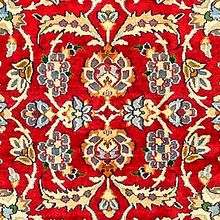Shahreza Rug
| Shahreza Rug | |
|---|---|
 Design of Shahreza Rug (Rugman) | |
| General information | |
| Name | Shahreza Rug |
| Original name | قالی شهرضا |
| Alternative name(s) | Shahreza Carpet (Ghomsheh Rug) |
| Origin | |
| Category | City, Village |
| Technical information | |
| Common designs | Medallion, Payper (Mihrab) |
| Common colors | Red, Blue, Navy Blue, Green, White |
| Dyeing method | Natural, Synthetic |
| Pile material | Wool |
| Foundation material | Cotton |
| Knot type | Asyemmetrical (Persian) |
Shahreza rugs originate from Shahreza, located in the central western region of Iran, in the Province of Isfahan, and enjoys a long and illustrious history of weaving Persian carpets. Originally known as Qomshen, it was renamed Shahreza when a holy figure named Imamzadeh Shahreza was buried there. Shahreza is well known for its exquisite tightly knotted Persian carpets woven using the asymmetrical Persian knot.
History
Materials
Foundation and Pile
Techniques and structures
Color and dyeing
Motifs and Designs
Shahreza weavings are floral and have designs that reflect the traditional Isfahan Shah Abbas style. The rugs are in allover or medallion designs.[1]
Weaving techniques
See also
References
- ↑ Moheban, 2015, p.523-524
Bibliography
Abraham Levi Moheban, (2015), The Encyclopedia of Antique Carpets: Twenty-Five Centuries of Weaving, NewYork: Princeton Architectural Press.